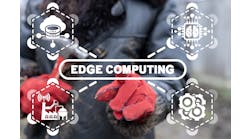A fundamental problem with the Industrial Internet of Things (IIoT) is just what to do with all that data. Much has been written about the sheer volume, velocity and variety of data thrown off by the myriad new IIoT sensors that are ever cheaper and easier to deploy. Take an offshore oil rig that spews 10 terabytes of downhole data each hour. Or an industrial gas turbine that throws off data at seven times the rate of the global Twittersphere.
Industrial companies have to look at new ways of handling data closer to where it’s generated, according to Mike Flannagan, vice president of data analytics, Cisco. “Connecting is just the starting point,” Flannagan says. “Data and process are the big challenges.”Clearly, industrial operators can’t expect to send all their data to the cloud and wait for instructions from on high. Indeed, many remote industrial operations are bandwidth-constrained: they couldn’t send all that data to the cloud even if they wanted to. Plus, they often need more real-time response than can be delivered by such centralized approaches.
Bandwidth limitations
Flannagan cites a recent industry survey in which 37% of respondents predicted that most data processing will be done at the edge within three years. This distributed analytical capability will add to the centralized structured and unstructured data approaches already being used, says Flannagan. “Cloud-based, big-data analytics provided by Hadoop clusters and SAP HANA will continue to be important, but data streaming at the edge will provide the next wave of insights.”
To help accommodate this new need for analysis at the edge, all manner of devices are getting smarter and more capable, and those advances start all the way down in the silicon. Virtualization, for example, has escaped IT server rooms and now is embedded into real-time control devices such as programmable controllers and industrial PCs. Virtualized, multi-core processors and systems-on-chips are now able to isolate deterministic control and safety functions from important but less mission-critical IIoT data-crunching, communication and visualization tasks.
HARTING is one company that includes virtualized, board-level applications in its new embedded product platform. Further, the modularity, security and openness of the platform represent the values of the larger “Integrated Industry” movement, according to Karsten Walther, team manager, embedded development, HARTING Technology Group. Within the platform, the company’s customers are free to combine their own designs with those supplied by HARTING to create new device designs that can then be shared with other developers. “A community will come together around the product platform that will—similar to an app store—offer customers and partners the opportunity to communicate with others and offer their solutions to others,” Walther says.
Meanwhile, embedded systems suppliers are making their devices more secure, starting at the lowest levels. “For example, Intel and ARM are developing processors and chips with encryption built right into the silicon,” says Albert Huang, vice president of Advantech’s industrial automation group. More secure devices complement the more secure networks also being developed, making data increasingly secure from end to end, Huang says.
It’s also increasingly difficult to distinguish smarter edge devices such as controllers from the more powerful network devices they’re connected to. What might have been viewed as a singularly functional switch or router a few years ago increasingly includes onboard computing capabilities that can do much more than just direct network traffic.
B+B SmartWorx, for example, offers what it calls an edge processing architecture to “bridge the gap between IT (information technology) and OT (operational technology),” according to Mike Fahrion, the company’s vice president of IoT technologies. Multifunctional wireless mesh network nodes based on Dust Networks’ SmartMesh IP technology aggregate data from existing equipment and translate disparate machine protocols into a language IT systems can understand, Fahrion explains.
Network as platform
Importantly, these intelligent boxes can be remotely managed and provide more than just “southbound connectivity” to legacy equipment and protocols. “They can host multiple containerized applications—even from third parties—to perform specific tasks such as analytics,” Fahrion says. “They can also share resources with one another. Add fiber backhaul to one, for example, and the other nodes have access to it, too. Now you have total flexibility.”
In effect, this edge processing architecture replaces the correlation of physical and functional edge devices with a logical edge and distributed “swarm intelligence,” paving the way for the autonomous and intelligent IIoT system components envisioned in scenarios of both the Industrial Internet Consortium and Industrie 4.0 camps.
“Swarm intelligence is the collective behavior of decentralized, self-organized systems, natural—like ants or bees—or artificial, that accomplishes a single goal even if no individual is in charge,” explains Tim Taberner, global product manager for B+B’s advanced IoT cellular gateways. “Simple components accomplish sophisticated tasks by following simple rule sets and working in groups.”
“Many swarm principles are replicated in the IoT,” Taberner adds. “However, for the IoT to realize its full potential in remote or demanding environments, edge devices must mature beyond simple data aggregation and filtering. They must begin to collaborate and make decisions on the intelligence gained from each other, without relying on upstream resources, to distribute intelligence and decision-making further to the edge.”
The fog gathers steam
Networking giant Cisco, too, is betting big on its ability to help manufacturers and other industrial verticals to tackle their analytics needs “out in the fog.” Its IOx platform and fog computing strategy platform has seen unexpectedly strong uptake among industrial stakeholders, according to Kip Compton, vice president and general manager of Cisco’s IoT Systems and Software Group. “For some time now, we’ve been designing our switches to include more compute power than really needed,” Compton says. “But with the IoT, we’ve found there’s a real benefit to putting compute capabilities in the switch.”
With their view of multiple devices, switches are ideally positioned to aggregate and analyze the large volumes of data inherent in the IIoT. Cisco’s DMo (Data in Motion) software, for example, runs in their routers, scoring data and often providing a 1,000-fold reduction in raw data volume for subsequent transmission. Meanwhile, cloud capabilities work in concert with edge capabilities, pushing device management and policies down to the edge. “But we need something local that can identify data of interest,” Compton says. “The bandwidth is too expensive!” Or, in many cases, isn’t there at all.




